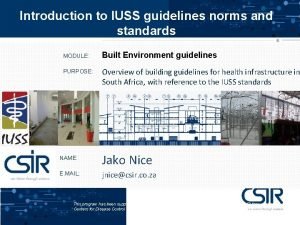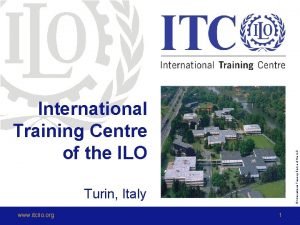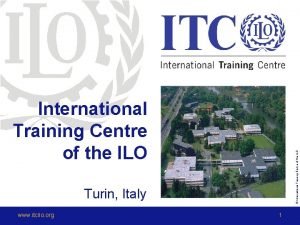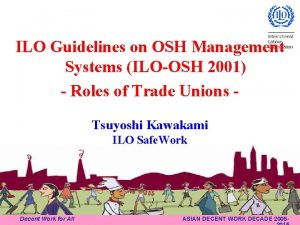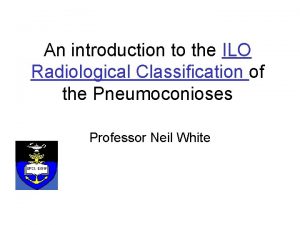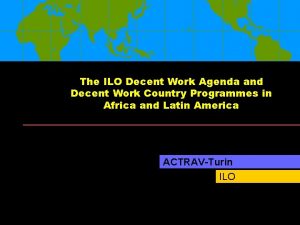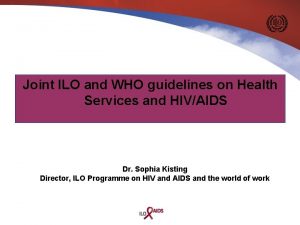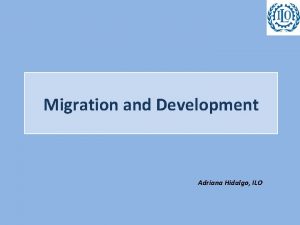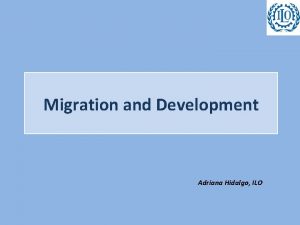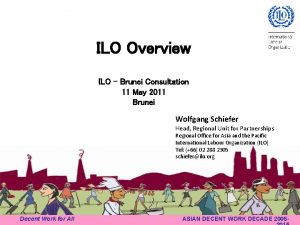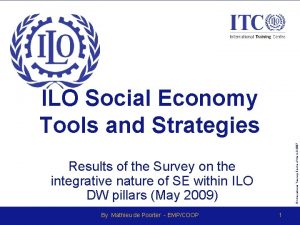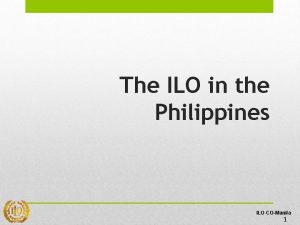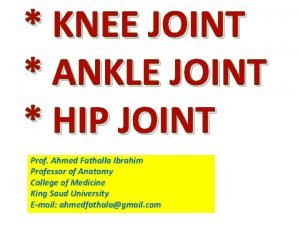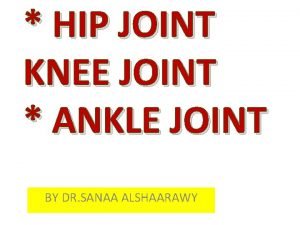Joint ILO and WHO guidelines on Health Services













- Slides: 13

Joint ILO and WHO guidelines on Health Services and HIV/AIDS Dr. Sophia Kisting Director, ILO Programme on HIV and AIDS and the world of work

Why focus on health workers? • Health workers make an important contribution to public health. • Health workers have been at the forefront in the response to HIV and AIDS, even though they face the risk of occupational exposure. • There is a major workload related to HIV and TB on health care workers particularly in high burden countries. • It is important to focus on protection of the rights of heath workers and improve their conditions of work. • The ILO Recommendation 200 comprehensively covers health workers.

The health sector as a workplace • Occupational risk in the health sector: § Stigma and blame attached to the reporting of sharps injuries § Lack of access to post-exposure prophylaxis (PEP) § Lack of adequate training and information. • Stigma and discrimination in the health sector could be: • By health-care workers towards their colleagues • Towards patients • By employers towards health-care workers • These are serious issues in many health-care settings undermining the provision of care as well as programmes for prevention

Safe and Healthy work environment under the Recommendation 200 • Incorporates the principle of a safe and healthy work environment for all workers, including those with an occupational risk of transmission, calling for universal precautions, post-exposure prophylaxis and other safety measures. • Measures should be taken to protect workers in occupations particularly exposed to the risk of HIV transmission.

The ILO contributes to the health of workers and workplaces through: Training during paid time (Convention No. 155) Workers’ education programmes, vocational training and apprenticeship programmes Health and safety committees, occupational health services Enhancing Gender equality and women’s entrepreneurship Solidarity; Social dialogue, Collective bargaining Public-Private Partnerships Extending social protection (e. g. decentralized health insurance and cash transfers)

Role of Competent Authorities • Governments, in collaboration with employers, workers and their representatives, and others should provide the relevant regulatory framework and, where necessary, revise labour laws and other legislation to include relevant provisions. • Governments should supply technical information and advice to employers, whether public or private, and workers and their representatives.

Role of employers’ and workers’ organizations • participate in the development and dissemination of standards, guidelines, policies and ethical frameworks that support HIV/AIDS programmes, including occupational safety and health standards; • raise awareness and build capacity amongst health-care workers to mitigate the impact of HIV/AIDS in the workplace; • ensure that health-care workers who are infected or affected are protected against stigma and all forms of discrimination; • work together with health-care workers to monitor compliance with all labour and OSH legislation and regulations; • strengthen the access of health-care workers to VCT, treatment and wellness programmes in the workplace.

The ILO/WHO guidelines on health services and HIV/AIDS

Scope of the ILO/WHO Guidelines: • Governments, public and private employers, workers and their representatives, professional associations, scientific and academic institutions, and all other groups and bodies with responsibilities and activities relevant to the delivery of health care. • Designed as a basis for practical policy and as a technical reference that can be used by – or adapted to the needs and capacities of – large, medium-sized or small health-service structures.

1. Joint ILO/WHO guidelines on health services and HIV/AIDS: Purpose: 1. promote sound management of HIV/AIDS in health services, including prevention of occupational exposure. 2. ensure that health-care workers have decent, safe and healthy working conditions. 3. ensure effective care that respects the needs and rights of patients, especially PLHIV.

2. Joint ILO/WHO guidelines on PEP to prevent HIV infection Post-exposure prophylaxis (PEP) is the medical response given to prevent the transmission of bloodborne pathogens following a potential exposure to HIV.

3. New Guidelines for the protection of Health Workers from exposure to HIV and TB • Health. WISE – a tool for a healthy work environ-ment for health workers. • Joint policy guidelines for health workers’ access to HIV and TB prevention, treatment, care and support services (goverment, employers and health workers). • This will be launched on World AIDS Day this year (1 st December 2010).

Guidelines and more information available from: http: //www. ilo. org/aids/Publications (soft copies in participants’ USB key)
 5 types of permanent joints
5 types of permanent joints Hinge joint
Hinge joint Cutability
Cutability Intertransverse ligament
Intertransverse ligament Memorandum of joint venture
Memorandum of joint venture Break joint vs spool joint
Break joint vs spool joint Iuss health facility guides
Iuss health facility guides Centro internazionale di formazione dell'ilo
Centro internazionale di formazione dell'ilo International training centre of the ilo
International training centre of the ilo Ilo turin courses
Ilo turin courses Ilo osh 2001
Ilo osh 2001 Ilo classification of pneumoconiosis
Ilo classification of pneumoconiosis Ilo classification of pneumoconiosis
Ilo classification of pneumoconiosis 4 pillars of decent work
4 pillars of decent work






